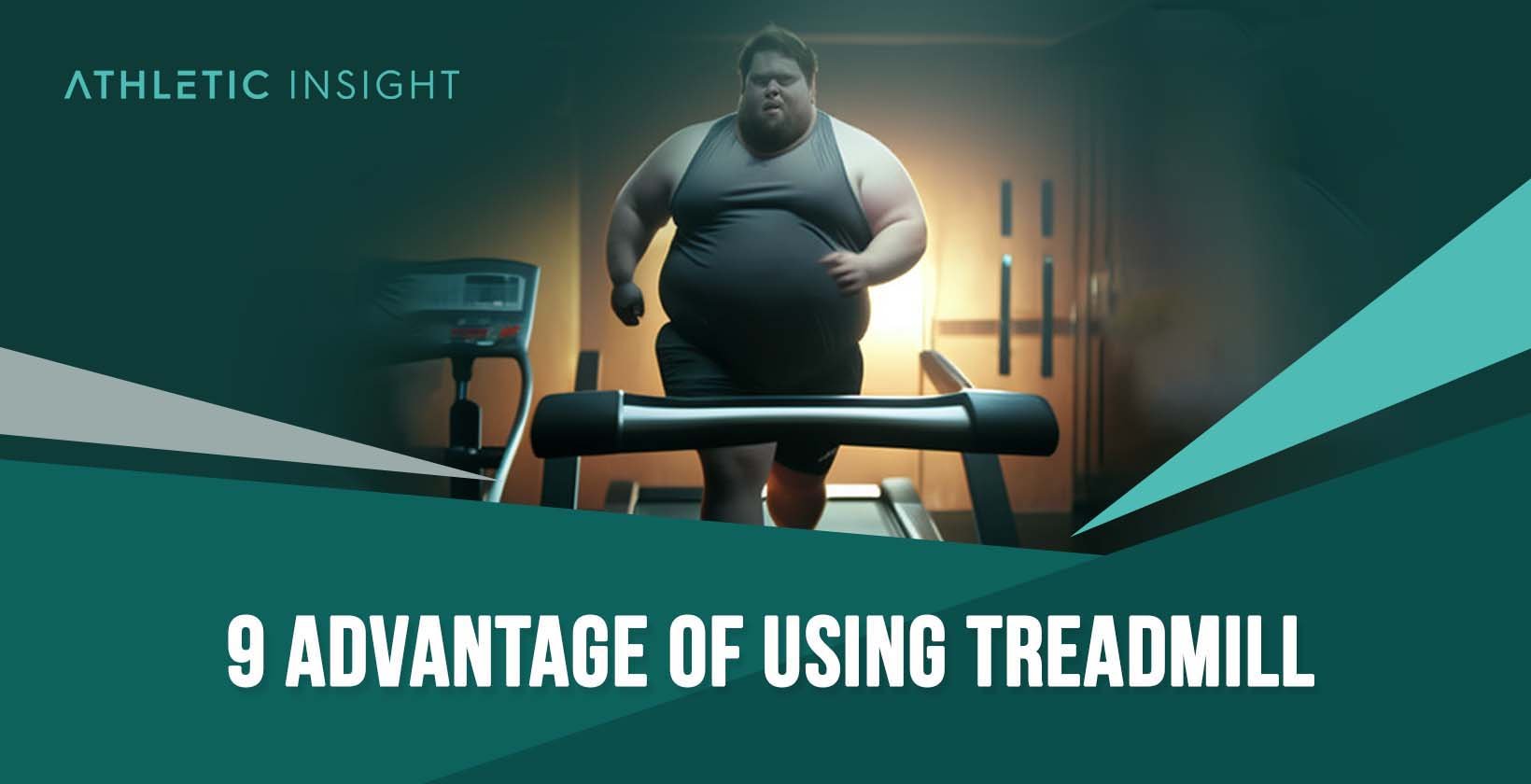Engaging in regular physical activity is essential for maintaining good health and well-being. One popular and effective way to achieve this is by using a treadmill. Treadmills are a popular piece of exercise equipment found in gyms, fitness centers, and homes around the world. Running on a treadmill offers numerous benefits, including convenience, safety, and versatility.
Whether the person engaging in treadmill exercise is a beginner or a seasoned runner, incorporating treadmill workouts into their fitness routine can provide a challenging and effective workout. This article explores the nine advantages of using a treadmill, including losing weight, reducing the impact on joints, and improving mental health.
- Effective Loss of Weight
- Good Cardio Exercise
- Build up your muscles
- Improve bone density
- Reduced Physical Stress
- Maintain Control of Your Diabetes
- Increasing your Balance
- Make mental health improvements
- Simple to Use and Store
1. Effective Loss of Weight
Weight loss is an integral component of a healthy lifestyle, and using a treadmill is a proven method to facilitate it. Treadmill workouts allow individuals to burn a significant number of calories by engaging in cardiovascular exercises, ultimately leading to effective weight loss.

The versatility of the treadmill allows for a range of workouts, from high-intensity interval training to steady-state cardio. Using a treadmill also allows for easy progress tracking, as a person can easily monitor the distance, speed, and calories burned. Incorporating treadmill workouts into a weight loss plan can lead to effective and sustainable results.
2. Good Cardio Exercise
Cardiovascular exercises enhance the overall health of the heart and lungs. Treadmill workouts are considered a superior form of cardio exercise, as they elevate the heart rate and improve the body’s ability to transport oxygen to working muscles.
Treadmill workouts allow individuals to control their workout’s intensity, duration, and incline, making it easy to customize to specific fitness levels. The constant movement of running or walking on the treadmill benefits cardiovascular endurance and increases oxygen flow to the body while burning calories. Regular use of a treadmill can also reduce the risk of heart disease, lower blood pressure, and improve overall health.
3. Build Up Your Muscles
Regular treadmill use can result in muscle development and toning. While primarily targeting the lower body, including the quadriceps, hamstrings, and calves, treadmill workouts can also engage the core and gluteal muscles, leading to a more robust and well-rounded physique. The constant movement of the treadmill can improve overall lower body strength, stability, and balance.

4. Improve Bone Density
Weight-bearing exercises, such as walking or running on a treadmill, are known to enhance bone density. These activities stimulate bone remodeling, leading to stronger bones and a reduced risk of osteoporosis in the long term.
Bone density is crucial to overall health, especially as people age. Regular exercise, such as when using a sports running machine, can help improve bone density and reduce the risk of osteoporosis. The impact of running or walking on the treadmill stimulates bone cells, increasing bone mineral density over time.
The weight-bearing nature of treadmill exercise can strengthen bones and help to maintain bone mass. Incorporating regular treadmill workouts, particularly weight-bearing exercises, can improve bone health and reduce the risk of bone-related injuries or conditions.
5. Reduced Physical Stress
Unlike outdoor running, which can strain the joints and ligaments due to uneven surfaces, treadmill workouts offer a cushioned and consistent surface. This minimizes the impact on the body, reducing physical stress and the risk of injury. Using a treadmill also allows for more controlled and stable movements, reducing the risk of injury or strain.
6. Maintain Control of Your Diabetes
Regular exercise is crucial for individuals with diabetes, as it helps regulate blood sugar levels. Treadmill workouts provide a consistent and controlled environment for aerobic exercises, aiding in the management of diabetes.
Treadmill exercise also promotes cardiovascular health, reducing the risk of heart disease and other diabetes-related complications. Regular exercise can help control weight and reduce stress, which are essential factors in managing diabetes.
7. Increase Your Balance
Treadmill use has the potential to improve balance and coordination, especially when incorporating incline and speed variations. As a result, individuals can experience enhanced stability in everyday activities and a reduced risk of falls.

The handrails on treadmills also offer support and can be used to assist with balance. Walking or running on an incline on the treadmill further challenges balance and can improve overall lower body stability.
8. Make Mental Health Improvements
Engaging in regular physical activity, including treadmill workouts, has been shown to boost mood and alleviate symptoms of anxiety and depression. Exercise releases endorphins, which contribute to feelings of happiness and well-being. The consistency and routine of treadmill exercise can also provide a sense of structure and control, reducing feelings of stress and anxiety.
9. Simple to Use and Store
Treadmills are user-friendly and often come with foldable designs, making them convenient for home use and storage. This advantage allows individuals to integrate treadmill workouts into their daily routines with ease.
Many treadmills are designed with space-saving features, such as foldable frames or compact designs, making them easy to store in small spaces when not in use. While larger commercial-grade treadmills require more space, the design of most home-use treadmills speaks to convenience and ease of use in mind.
How to Choose the Best Treadmill to Purchase?
When selecting a treadmill, consider factors such as budget, available space, personal fitness goals, and desired features. Conduct thorough research and read reviews to identify the best treadmill that meets your specific needs.
- Establish a budget and determine how much is available to spend on one purchase.
- Consider the motor power of the treadmill to ensure it can support the correct level of workout intensity and frequency.
- Check the size of the running deck to ensure it can accommodate the necessary stride length and provide ample space for comfortable movement.
- Look for a treadmill with incline options to allow for a more challenging workout and target specific muscle groups.
- Consider the features of the treadmill display and technology, such as pre-programmed workouts, heart rate monitors, and Bluetooth connectivity.
- Look for a treadmill with a sturdy frame and a solid warranty to ensure durability.
- Ensure the treadmill’s weight capacity can safely support the individual’s weight.
What is the Best Treadmill?
The best treadmill varies depending on individual preferences and requirements. Based on quality and value, the best overall treadmill currently on the market is the NordicTrack Commercial 1750 or the Sole F80 depending on budget. Other high-quality options include the other NordicTrack Commercial Series, Sole ST90, and ProForm Pro 2000.
What is the Best Treadmill for Home Use?
The best treadmill for home use combines durability, compactness, and user-friendly features. Overall, the Sole F80 is the best home treadmill. The NordicTrack T Series, Sole F63, and Horizon Fitness T101 are also popular choices for home use, as they offer a balance of performance, convenience, and affordability.
What is the Best Treadmill for Running?
For avid runners, a treadmill with a powerful motor, large running surface, and advanced cushioning system is essential. The ProForm Pro 9000, NordicTrack Commercial 1750, and Sole F80 are top contenders for the best treadmill for running.
Having a cushioned running surface provides excellent joint protection while running, and the NordicTrack Commercial 1750 cushioning feature lets individuals adjust the cushioning to their preferred level of support. Treadmill running benefits are plentiful, and the type of exercise running machine is critical to this level of fitness.
What are the Disadvantages of a Treadmill?
Despite their numerous advantages, treadmills also have some drawbacks. These include the initial cost, ongoing maintenance, and potential for a monotonous workout experience. Moreover, running on a treadmill may not fully replicate the experience of outdoor running, as factors such as wind resistance and terrain variation are absent.
There is a risk of injury when using a treadmill if one does not take proper precautions during exercise, such as not warming up or wearing appropriate footwear. There is also a risk of falling if the speed or incline is too high or the person loses their balance.
Another potential disadvantage is the noise level, as some treadmills can be quite loud, especially when used in a shared living space. Treadmills provide a different sensory experience than running outdoors, as individuals will not experience variations in terrain or scenery – although technology is starting to incorporate this feature.
Finally, treadmills can take up significant space, especially if they are not foldable or collapsible. Running on a treadmill can also be less enjoyable for some people than running outdoors, as it can feel repetitive and monotonous.
What is the Average Cost of a Treadmill?
The average cost of a treadmill varies widely, ranging from a few hundred dollars for basic models to several thousand dollars for high-end options. Ultimately, the decision to purchase a treadmill depends on individual circumstances, such as budget and fitness goals.
The cost of a treadmill can also depend on factors such as the motor’s size and power, the running deck’s size and quality, the available workout programs and features, and the overall durability and warranty of the machine.
Is it Expensive to Purchase a Treadmill?
No, purchasing a treadmill is not expensive, especially when considering one’s health. In terms of a financial expense, whether a treadmill is considered expensive depends on personal budget constraints and expectations.
While high-quality treadmills can be costly, more affordable options are available for those with limited budgets. Investing in a treadmill that meets your needs and lasts for years can be a worthwhile expenditure. Investing in a higher-quality treadmill will save money in the long run by reducing the need for costly repairs or replacements.
What Treadmill Exercise is Most Effective?
The most effective treadmill exercise depends on individual goals and fitness levels. For weight loss and cardiovascular health, interval training that incorporates varying speeds and inclines is highly effective. For muscle building and endurance, a combination of steady-state and hill workouts can be advantageous.
Incline walking and running can also effectively engage the lower body muscles and burn more calories than flat surface walking or running. Ultimately, the most effective treadmill exercise is one that is challenging yet enjoyable for you that can be sustained over time to achieve your fitness goals.
How Does Using a Treadmill Impact the Body?
Using a treadmill positively impacts the body in various ways such as cardiovascular health, muscle strength and tone, bone density, mental health, and stress.
- Cardiovascular health: Cardiovascular health improves as the heart and lungs become more efficient at transporting oxygen to the muscles.
- Muscle strength and tone: Muscle strength and tone are enhanced, particularly in the lower body and core.
- Bone density: Bone density also increases due to the weight-bearing nature of treadmill exercises, reducing the risk of osteoporosis.
- Mental health: Mental health benefits are achieved through the release of endorphins that elevate mood and alleviate stress.
However, like any form of exercise, using a treadmill can also negatively impact the body if performed improperly or excessively, such as causing joint pain, muscle strains, or overuse injuries.
How Often Per Week Should You Use a Treadmill?
Experts recommend engaging in at least 150 minutes of moderate-intensity aerobic exercise or 75 minutes of vigorous-intensity aerobic exercise per week. This can be achieved through treadmill workouts, ideally spread across three to five sessions per week to allow for adequate recovery time.
For general fitness and health maintenance, experts recommend that people engage in moderate-intensity aerobic exercise, such as treadmill walking or running, for at least 30 minutes per day, five days per week. Listening to the body and avoiding overexertion or injury is essential, as gradually increasing the frequency and intensity of treadmill exercise over time.
Is it Healthy to Use a Treadmill Every Day?
Yes, using a treadmill every day can be healthy, provided the intensity and duration of the workouts are appropriate and allow for sufficient recovery time. It is essential to listen to your body and adjust your exercise routine accordingly to avoid overtraining or injuries. Individuals with pre-existing health conditions or injuries should consult a healthcare professional before starting a daily treadmill exercise routine.
Does Using A Treadmill Help You Lose Belly Fat?
Yes, using a treadmill can help you lose belly fat by burning calories and contributing to overall weight loss. While it is impossible to target fat loss in specific areas, consistent aerobic exercise combined with a balanced diet and strength training can lead to a reduction in belly fat over time.
When a person exercises on a treadmill, their body burns calories, and if they maintain a caloric deficit, their body will start to burn fat, including belly fat, for energy.
Running or brisk walking on a treadmill is an effective way to burn calories and increase heart rate, which can help individuals lose fat and tone muscles in the belly area. Many will start to notice a slimmer physique after routine treadmill exercise.
However, combining regular treadmill exercise with a balanced and healthy diet is essential to achieve significant and sustainable fat loss. While walking or running on a treadmill will help a great deal, if a person’s diet is poor, all of the positive work will be short-lived.



